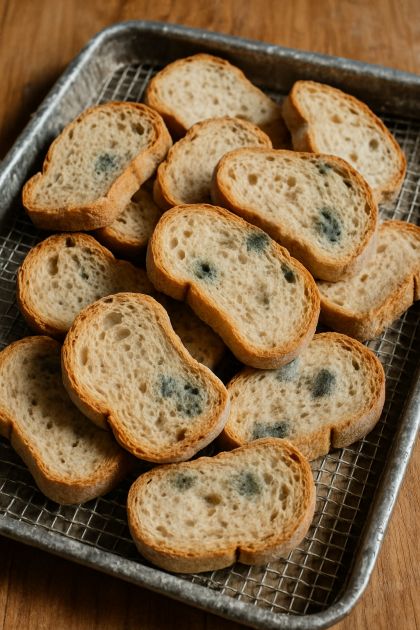There are several creative ways to bring stale bread back to life. One popular method is to sprinkle the bread with a little water and then place it in a preheated oven at 350°F (175°C) for about 10 minutes. This can help restore some of the moisture and make the bread more palatable.
Another option is to use stale bread in recipes that naturally incorporate moisture, such as French toast, bread pudding, or stuffing. These dishes can transform dry bread into a delicious meal, making the most of what might otherwise be wasted.
5. Popular Viral Hacks for Using Stale Bread
Social media is full of viral hacks for using stale bread. One popular hack involves using stale bread to make homemade breadcrumbs. Simply grind the bread in a food processor and store the crumbs in an airtight container for future use in recipes like meatballs or as a topping for casseroles.
Another trending hack is to use stale bread to make croutons. Cut the bread into cubes, toss with olive oil and your choice of seasonings, and bake until crispy. These croutons can add a delightful crunch to salads and soups.
6. Nutritional Value: Does Stale Bread Lose Its Benefits?
Stale bread retains most of its nutritional value, as the primary change is in texture rather than composition. Bread is a source of carbohydrates, fiber, and some vitamins and minerals, and these nutrients remain intact even as the bread becomes stale.
However, if the bread is enriched or fortified, some of the added nutrients may degrade over time. It’s also worth noting that the enjoyment of eating stale bread may decrease, which could affect how often you choose to consume it.
7. How to Properly Store Bread to Prevent Staleness
Proper storage is key to preventing bread from going stale. Bread should be stored in a cool, dry place, ideally in a bread box or a paper bag that allows some air circulation. Avoid storing bread in the refrigerator, as this can accelerate staleness due to the cold temperature causing the starch to crystallize faster.
If you have more bread than you can consume in a few days, consider freezing it. Wrap the bread tightly in plastic wrap or aluminum foil and place it in a freezer bag. When you’re ready to use it, thaw the bread at room temperature or toast it directly from the freezer.
8. When to Draw the Line: Signs Your Bread Is Beyond Saving
While stale bread can often be salvaged, there are times when it’s best to let it go. If you notice any signs of mold, such as fuzzy spots or an off smell, it’s time to discard the bread. Mold can spread quickly, even if it’s not visible on the entire loaf.
Additionally, if the bread has been stored for an extended period and has become extremely hard or has an unpleasant taste, it may not be worth saving. In these cases, it’s better to prioritize safety and quality over waste reduction.
9. Cultural Perspectives on Food Waste
Different cultures have varying perspectives on food waste. In many European countries, for example, there is a strong tradition of using every part of food, including stale bread, in creative ways. Dishes like Italian panzanella or French pain perdu (French toast) are traditional recipes that make use of leftover bread.
In contrast, some cultures may prioritize freshness and discard food that is no longer at its peak. Understanding these cultural differences can provide insight into how we approach food waste and inspire us to adopt more sustainable practices.
10. Expert Opinions: What Chefs Say About Stale Bread
Many chefs view stale bread as an opportunity rather than a problem. Renowned chefs often emphasize the importance of minimizing waste and finding creative uses for ingredients that might otherwise be discarded. Stale bread can be a versatile ingredient in the kitchen, lending itself to a variety of dishes.
Chef Massimo Bottura, for example, is known for his commitment to reducing food waste and has created recipes specifically designed to use stale bread. His approach highlights the potential for culinary innovation and sustainability.
11. Making the Decision: Factors to Consider
When deciding whether to use or discard stale bread, consider factors such as safety, taste, and environmental impact. If the bread is safe to eat and can be used in a way that enhances its flavor, it may be worth saving. However, if the bread is moldy or unappetizing, it’s best to prioritize health and quality.Ultimately, the decision comes down to personal preference and values. By being informed about the options and potential benefits of using stale bread, you can make a choice that aligns with your priorities and contributes to a more sustainable lifestyle.

Pulled out some stale bread from pantry. My mother-in-law says it’s wasteful not to use it, but it looks bad to me. What should I do?
ADVERTISEMENT
For Complete Cooking STEPS Please Head On Over To Next Page Or Open button (>) and don’t forget to SHARE with your Facebook friends
ADVERTISEMENT